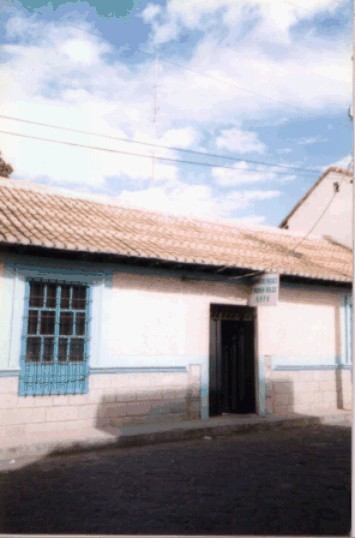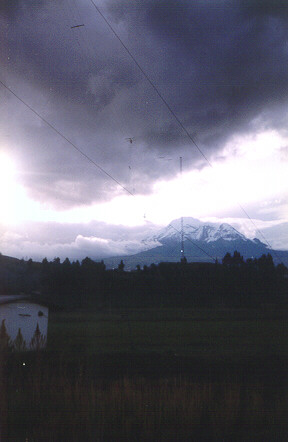

|
- |  We
then set out for Riobamba, two hours south of Ambato. Riobamba is a popular
destination for tourists who want to climb the monolithic volcano, Chimborazo,
at 6310m above sea level. The town center is lined with cobblestone streets
and colonial houses, a refreshing change from the bustle of Ambato. Elsa
and I decided to waste no time and jumped into a taxi to go straight to
the city’s Escuelas Radiofónicas Populares del Ecuador (ERPE.)
By now the clock was nearly striking three and only God knows when the
business day is considered over in Ecuador. We
then set out for Riobamba, two hours south of Ambato. Riobamba is a popular
destination for tourists who want to climb the monolithic volcano, Chimborazo,
at 6310m above sea level. The town center is lined with cobblestone streets
and colonial houses, a refreshing change from the bustle of Ambato. Elsa
and I decided to waste no time and jumped into a taxi to go straight to
the city’s Escuelas Radiofónicas Populares del Ecuador (ERPE.)
By now the clock was nearly striking three and only God knows when the
business day is considered over in Ecuador.
Listeners can hear the station’s educational programs on 5010.1 kHz between 0000 and 0200 GMT nightly. Unfortunately, they are using only 500 to 800 watts in order to preserve the equipment, and when the time comes that a replacement is needed… ERPE will probably lose its SW voice. Reports are promptly answered with a letter and, when available, large pennants which reflect the project’s community orientation. After the interview, we took a stroll into a classroom and Juan showed me the foundation's growing collection of radio station pennants. He said that they're useful to educate students about the world around them. We then returned to the office, where engineer Lauro offered to take Elsa and I to see the antenna and transmitter. I thanked the friends I’d met and hopped into his car for the 20-minute ride.  The
three of us pulled into a section of farmland and more or less bounced
through what once was a road until we came upon the site. ERPE’s MW tower
and SW dipole lie literally in the massive shadow of the snow-capped Mt.
Chimborazo. I stood in awe of the folded dipole hanging between two 50’
towers, as if juxtaposed over the sleeping volcano. Off to the side of
the antenna is a traditional Indian hut, where the station’s guard appeared.
Lauro explained to me that the guard doubles as a farmer for their export
project and pointed to the cultivated ground. “This is the quinia we’ve
been talking about,” he laughed. The
three of us pulled into a section of farmland and more or less bounced
through what once was a road until we came upon the site. ERPE’s MW tower
and SW dipole lie literally in the massive shadow of the snow-capped Mt.
Chimborazo. I stood in awe of the folded dipole hanging between two 50’
towers, as if juxtaposed over the sleeping volcano. Off to the side of
the antenna is a traditional Indian hut, where the station’s guard appeared.
Lauro explained to me that the guard doubles as a farmer for their export
project and pointed to the cultivated ground. “This is the quinia we’ve
been talking about,” he laughed.
Within a large shed live the MW and SW transmitters. The SW unit, standing over 6’ tall and 4’ wide, was donated almost forty years ago by a French foundation. I was amazed to stare into the monolith – the same monolith that rides through the static every night with the music and programs of ERPE. After taking a few pictures, Lauro drove us back to Riobamba where we found another bus. We hopped on as the sun went down and headed straight for Baños, a venerable tourist trap. Elsa had called a friend of hers who lives there and got permission for us to stay the night. Little did I know how interesting things were about to become. |